https://www.youtube.com/watch?v=OUU22JeVROE
How to Solve a 4x4x4 Rubik's Cube - Part 3 - Parity Errors
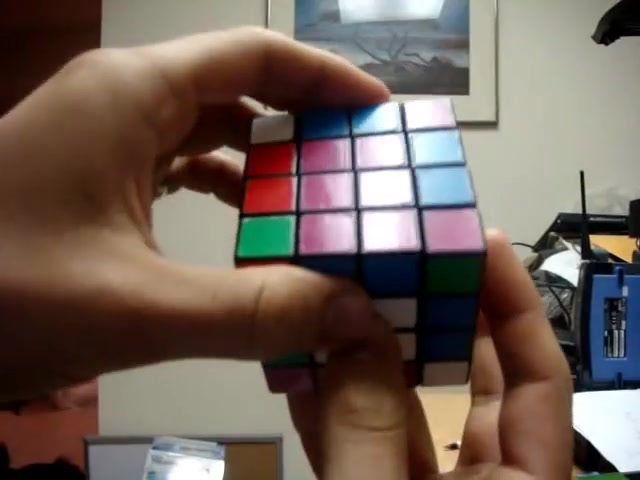
All right , welcome to the third and final step of how to solve a four by four , Rubik's cube .
Revenge .
At this point , you should have a cube that resembles a mixed up three by three cube where all of the centers have been positioned correctly .
And also all of the edges have been paired up with their complimentary piece .
Now , I am going to display both the algorithms from solving the three by three Q which I use to solve the four by four and also the new algorithms we're going to use to fix parody .
However , I'm not going to reteach the three by three algorithms in this video .
So if you don't know exactly how to use them , you should refer to my three by three tutorial on the playlist on my page .
When using my method for solving the four by four , there are basically only three total parity cases that you need to worry about .
And the first one we already learned at the end of the second step .
So let's go on to solve the cube as a three by three .
Now , basically you should already know how to solve a three by three So I'm not going to explain in detail some steps which involve basic three by three moves .
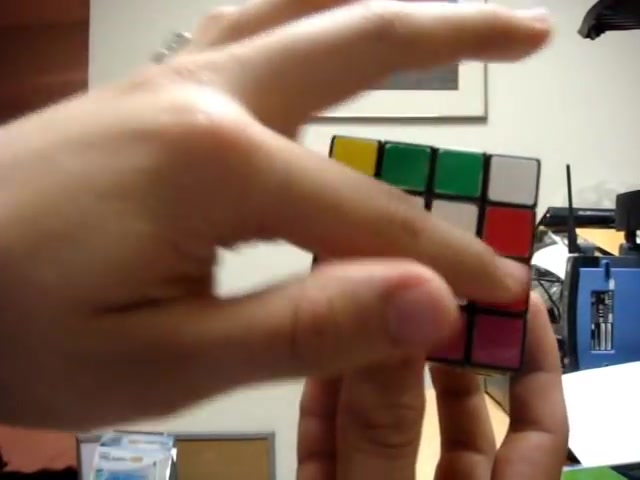
OK .
So for purposes of solving the four by four cube as a three by three , these double edge pieces here can be considered the same as these single edge pieces on the three by three .
Also this four piece center can be considered the same as a single piece center on a three by three as well .
So the only thing that stops us from solving the four by four completely as a three by three are going to be the parody cases , which I'm going to show you how to correct in this video .
So I like to place the white as my bottom and the yellow as my top knowing that I can then go on to solve the bottom white cross as I would with a three by three .
So let me do that .
So what I'm going to do is make the bottom white cross .
So now you can see I have a cross on the bottom that is comparable to having a white cross on the bottom of a three by three .
Each of these edges have been paired up with its side center and it's also with its bottom center .

So then what I do is I place each of these corner pieces down with its respective edge piece , which is basically comparable to a middle edge piece on a three by three .
So let me go ahead and do that as well .
So there I have one placed to place another one which is there , here's the third one and for the last one , I have placed it here .
So now I have placed all three bottom layers of the four by four .
This is basically the same as placing the first two layers of a three by three .
So now what we want to do is to solve the top cross .
OK .
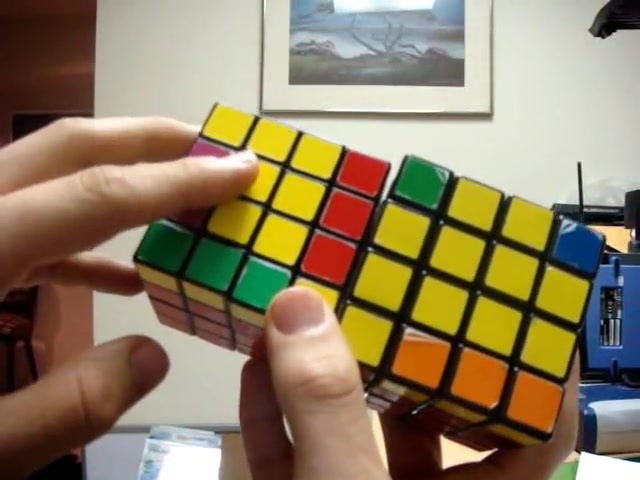
So before trying to solve the top cross , we have to first to see whether or not the cube has a parody error .
If you do have a parody error at this point , you will have a cube that looks very similar to either of the two cubes I have in front of me .
Now , if it doesn't , and it looks something more like one of the four following patterns here where it has a single dot A horizontal line , a backwards L or if it has the cross already , then you do not have a parity error .
And you can basically get from any of these steps directly to this one without having to fix parity .
In this case , if you do have a cube like one of the two .
However , you basically want to get a cube that looks like this one .
So you want to change this so that it looks like this one .
In this case , what we're going to be able to do from this step is to flip this edge pair over .
In that case , we would have a complete cross .
So let me first show you how to change this one .
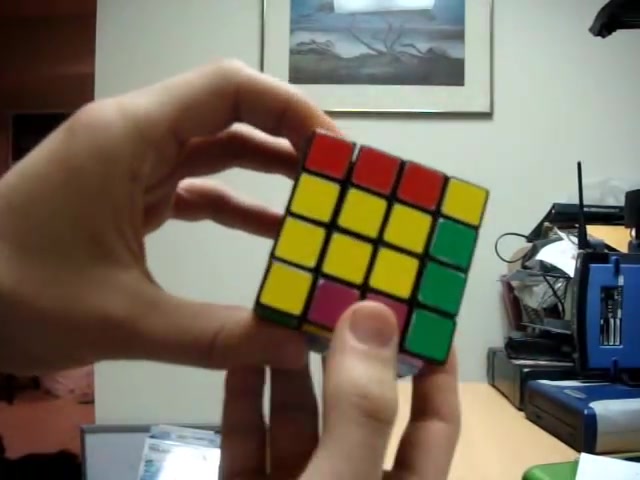
If you have it into a three quarters cross as I call it , that basically just has one edge pair flipped .
So what we're first going to do is we're going to hold the cube so that we have this two by three block , basically horizontal .
And also , so that we have a missing pair on the right side .
So we basically want this two by three block all the way to the left horizontal on the top face .
Then we're going to perform the following move .
That is also performed in the fourth step of the three by three tutorial .
So that move is front clockwise , top clockwise , right clockwise , top , counter clockwise , right , counterclockwise and front , counter clockwise .
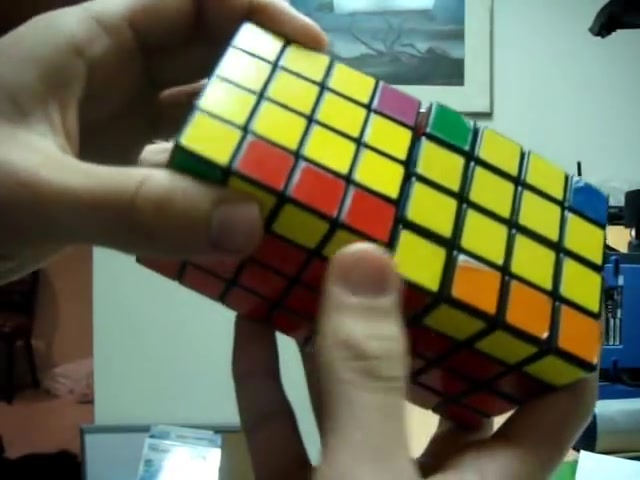
So now you'll see that we have basically the same pattern here where we have a 33 quarters cross and basically this edge piece has been flipped over .
So now we're going to have to memorize a longer algorithm which basically flips this edge piece over .
And I'd say this is probably one of the longer algorithms you're going to have to memorize in order to solve the four by four and also the five by five as well .
So the algorithm that we're going to have to memorize is first of all , we want to have this , this flipped edge pair , we want to have it right in front here on the top face .
Then we're going to perform the following algorithm in order to flip it over and finish the cross .
So we're going to do both right layers 100 and 80 degrees , the back face , 100 and 80 degrees , the up face , 100 and 80 degrees .
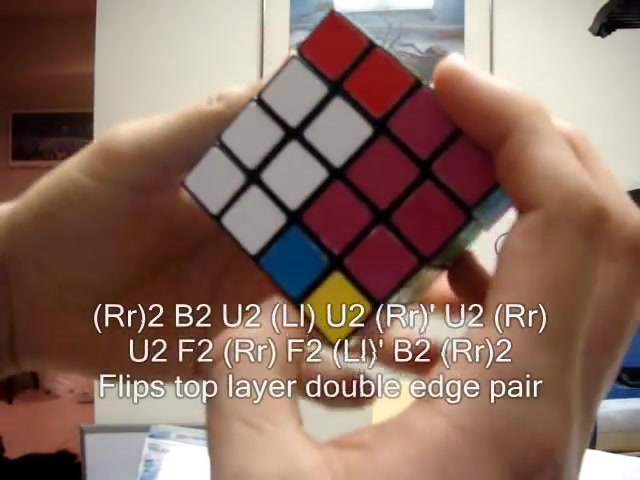
Both left faces clockwise , the up face 100 and 80 degrees , both right faces counter clockwise , the up face 100 and 80 degrees .
Both right faces clockwise .
Then we're going to do the up face 100 and 80 degrees .
The front face 180 degrees , both right faces clockwise , the front face 180 degrees .
Both left faces counter clockwise , the back face 100 and 80 degrees .
And we're going to do both right faces 100 and 80 degrees .
So what you should see at this point is that you have a completed cross .
So what we're going to do now is basically finish the top face so that it is one solid yellow color .
OK .
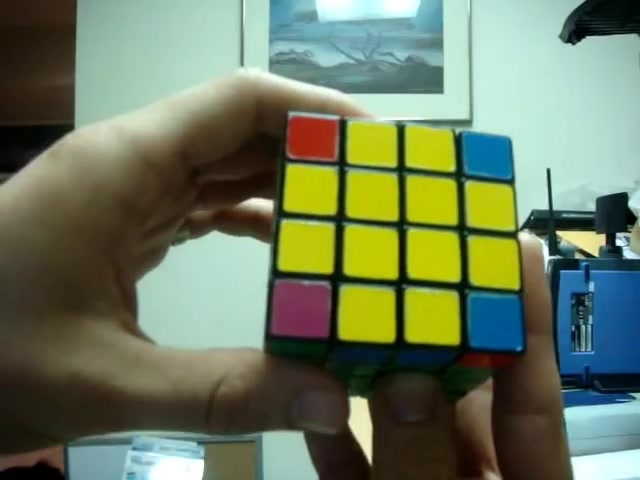
So at this point , you should have a yellow cross on the top face of the cube because we correct the previous parody error in which that one edge piece was flipped .
We can now solve the entire yellow face exactly like a three by three .
So you should know how to complete the top face of the cube , which is explained in detail in the fifth step of my three by three tutorial .
I will provide the algorithms .
However , so you can see which algorithm I am using , but you should know how to position the cube correctly already .
So what I'm going to do now is to solve the entire top face .
The algorithm I'm going to use is right clockwise , top clockwise , right , counterclockwise , top clockwise , right clockwise , top 100 and 80 right counterclockwise .
I'm then going to use that same algorithm again to complete the top face .

So right clockwise , top clockwise , right , counter clockwise , top clockwise , right clockwise , top 100 and 80 then right , counter clockwise .
OK .
So now since the entire top face is complete , we want to position the top corners .
So we look around the top layer until we find two adjacent top corners which have the same color as we do here .
This is now denoted as the back face .
So setting this as the back face , we then perform another algorithm which corresponds with step six in my tutorial .
So that algorithm is right counterclockwise , front clockwise , right counterclockwise , back 100 and 80 degrees , right clockwise , front , counter clockwise , right , counter clockwise , back 100 and 80 degrees and right 100 and 80 degrees .
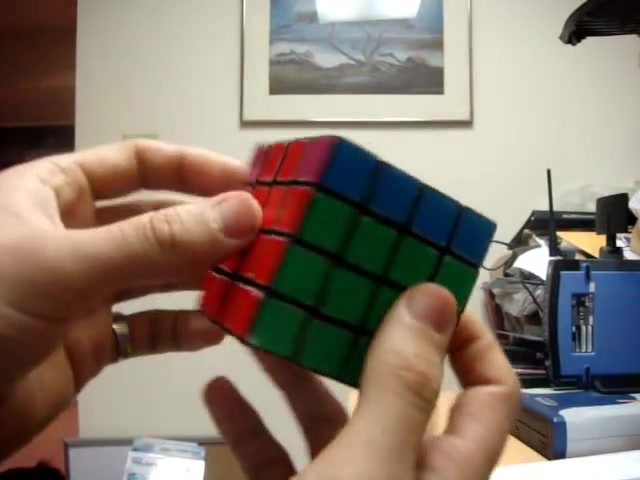
So what we'll see in this case is that we have one solid side here and another solid side on the opposite side .
So this goes on the green side and this goes on the blue side So we'll flip it 180 degrees .
OK .
So now what you'll see is that the two top edge pieces here , the two top edge pairs have been flip flopped .
This goes on the red side and this goes on the purple side .
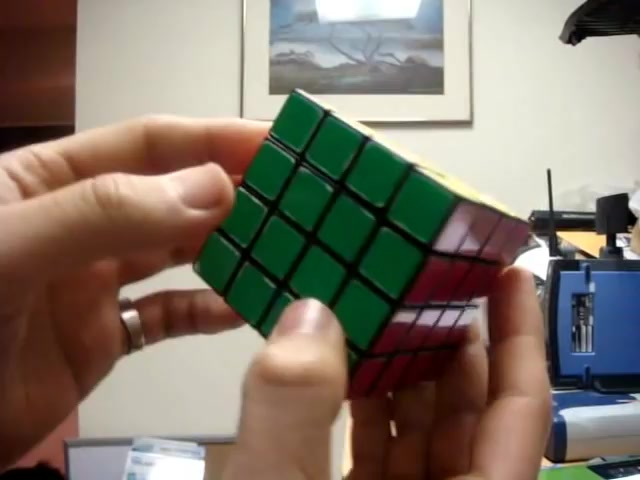
So the algorithm which we're going to have to know in order to flip flop , these two edge pairs is the following inside , right face , 180 degrees up face , 100 and 80 degrees inside right face again , 100 and 80 degrees , both up faces , 100 and 80 degrees inside right face , 100 and 80 degrees , the both up faces 100 and 80 degrees .
And then we're going to rotate just the top face 100 and 80 degrees .
So if you completed that move correctly , you should have a completed cube .
You might also have to perform the step seven part of my tutorial which you perform the Allen algorithm as well .
All right .
So I hope that this tutorial was helpful and allowed you to better understand the methods for solving the four by four cube .

As always , you can send me a message on youtube or post questions or comments on any of the steps for solving the four by four .
I'm also thinking about making a tutorial for the five by five as well .
So please let me know if you like the style of this tutorial .
So I could determine if I should make a five by five tutorial in a similar way .
Thank you all for watching as well .
Are you looking for a way to reach a wider audience and get more views on your videos?
Our innovative video to text transcribing service can help you do just that.
We provide accurate transcriptions of your videos along with visual content that will help you attract new viewers and keep them engaged. Plus, our data analytics and ad campaign tools can help you monetize your content and maximize your revenue.
Let's partner up and take your video content to the next level!
Contact us today to learn more.